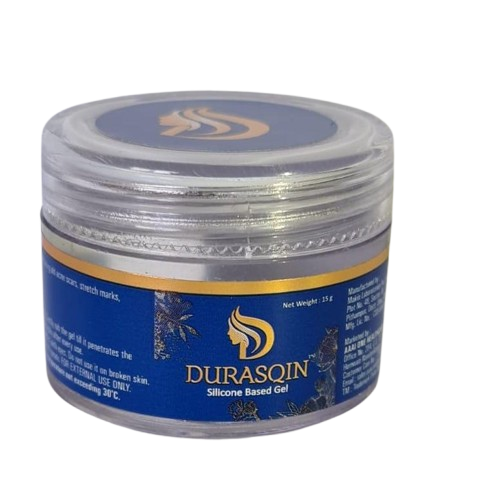
DURASQIN
Silicone gel combined with vitamin E represents an effective strategy for managing scars and keloids. By harnessing the protective and healing properties of both agents, this treatment can enhance skin recovery and improve cosmetic outcomes. As research continues to evolve, this approach holds promise for individuals seeking effective solutions for scar management. For optimal results, it is advisable to consult a dermatologist to tailor a treatment plan that addresses individual needs and conditions.
Introduction
Scars and keloids are common skin concerns that can arise from injuries, surgeries, or conditions such as acne. They can significantly impact an individual’s aesthetic appearance and emotional well-being. Effective management of these skin imperfections is essential, and recent advancements in dermatological treatments have highlighted the combined use of silicone gel and vitamin E as a promising approach.
Mechanism of Action
Silicone Gel: Silicone gel is a well-established treatment for scars, particularly hypertrophic scars and keloids. Its primary mechanisms include:
1. Hydration: Silicone gel creates a protective barrier over the scar, retaining moisture and preventing the formation of excessive collagen, which is crucial for optimal healing.
2. Oxygen Permeability: The gel allows oxygen to reach the scar tissue while shielding it from external irritants.
3. Pressure Application: The gel can exert gentle pressure on the scar, which helps to flatten and soften raised scars.
Research indicates that silicone gel can effectively reduce scar thickness, color, and texture, leading to improved cosmetic outcomes.
Vitamin E:
Vitamin E is a potent antioxidant that plays a significant role in skin health. Its contributions to scar management include:
1. Antioxidant Properties: Vitamin E protects skin cells from oxidative stress, which can impair healing and contribute to scar formation.
2. Moisturization: It aids in hydrating the skin, promoting elasticity, and improving overall skin texture.
3. Anti-inflammatory Effects: Vitamin E can reduce inflammation and promote healing, making it beneficial in the early stages of scar formation.
Combined Benefits
The combination of silicone gel and vitamin E can enhance the effectiveness of scar treatment. While silicone gel provides a protective, moisture-retaining barrier, vitamin E contributes additional nourishment and healing properties. This synergistic effect can lead to:
– Enhanced Healing: Together, they promote a more favorable environment for skin regeneration.
– Improved Aesthetics: Patients often report improved scar appearance, including reduced redness and enhanced smoothness.
– User Compliance: Silicone gels are typically easy to apply and can be incorporated into daily skincare routines, potentially increasing adherence to treatment protocols.
Clinical Evidence
Studies have shown that the use of silicone gel, particularly when combined with vitamin E, leads to significant improvements in the appearance of scars. Clinical trials indicate that patients using these treatments experience better outcomes in terms of scar texture, thickness, and color compared to those receiving no treatment or alternative therapies.
Application and Considerations
When using silicone gel with vitamin E for scar and keloid management:
1. Consistency is Key: Regular application, usually recommended twice daily, is essential for optimal results.
2. Duration of Treatment: Continuous use for several months may be necessary to achieve significant improvements.
3. Skin Sensitivity: Although generally well-tolerated, some individuals may experience sensitivity or allergic reactions. A patch test is advisable before widespread use.
